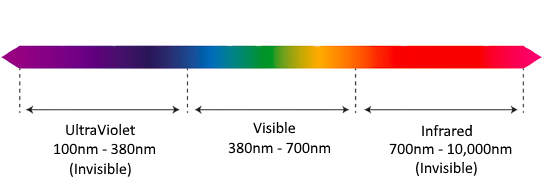The first step in finding the right laser for your application is to define the laser type. Whether it's a Laser Diode, a CW Laser / LD Module, or a Pulsed Laser, the type of laser you select will determine what main characteristics are important to your application. For example, if you select a CW laser module, the pulse width and repetition rate are not characteristics for CW Lasers.
Once the laser type is chosen, the next step is to define the main laser specifications needed in your laser. These typically include the wavelength, the beam, any optical parameters, the integration level, and the pulse width and repetition rate, if applicable. The importance of each of these characteristics will depend on your application. For some applications, the exact wavelength may not be important, but excellent beam quality or specific pulse width is critical. In other applications, the wavelength must be tightly controlled with a narrow spectrum, while you can be flexible with other specifications. Knowing the critical specifications for your application is a crucial part of selecting the right laser source.
Here is some information on the laser characteristics that will need to be defined:
Wavelength:
The output wavelength of a laser depends on the laser material, the process of stimulated emission, the optics of the laser resonator, and additional optical components outside the resonator (e.g., non-linear crystals for 2nd, 3rd, 4th, or 5th harmonic generation). As you increase in level of harmonic generation, overall power efficiencies of the laser decrease, as more and more losses are introduced into the system. For each transition between energy levels, a given material can support stimulated emission over a limited range of wavelengths. The probability of stimulated emission varies with wavelengths. The process concentrates emissions at wavelengths with higher stimulated emission probabilities.
Solid-State Lasers and Laser Diodes are available in wavelengths from the deep UV, through Visible and IR, and into the LWIR (long-wave infrared) spectral regions. This laser light wavelength chart provides a quick visual breakdown of UV, Visible, and IR spectral regions.
 |
| Wavelengths |
Not all laser types are available in all wavelengths. In many cases, the laser type defines which wavelengths are available.
Laser Diodes:
Laser Diodes are available in many wavelengths from ≈ 370 nm (UV) through 16 µm (LWIR). The wavelengths are determined by the material structure used to make the laser diode. Some of the common Epitaxial materials for laser diode are:
InGaN - 375 nm - 525 nm
AlGaInP - 622 nm - 1000 nm
AlGaAs - 622 nm - 1000 nm
InGaAsP - 1000 nm - 2100 nm
GaInAsSb - 1800 nm - 3000 nm
DPSS Lasers:
CW and Pulsed Diode-Pumped Solid-State Lasers are available in a wide range of wavelengths based on the gain medium material. Some of the more common materials and lasing wavelengths are:
Nd:YAG - 1.064 µm
Nd:YLF - 1.047 µm and 1.053 µm
Er:Glass - 1.55 µm
Er:YAG - 2.94 µm
From the fundamental wavelengths, additional wavelengths can be achieved by frequency doubling or second harmonic generation. For example, the most common diode pumped Nd YAG laser emission wavelength is 1064 nm. From 1064 nm, outputs at 532 nm, 355 nm and 266 nm can be generated by frequency doubling, frequency tripling, and frequency quadrupling, respectively (i.e., 532 nm is the result of a frequency doubled YAG rod @ 1064 nm). Other emission lines for Nd: YAG includes 946nm, 1123 nm, 1319nm, 1338 nm, 1415 nm and 1444 nm. With the proper optimization, weaker transition lines one can obtain substantial output power. A great example of these alternate emission lines available from Nd:YAG and Nd:YLF based lasers is our Q-SHIFT Series of shifted wavelength, pulsed DPSS lasers.
Beam and Optical Parameters:
A laser beam has the following important characteristics:
Directionality: An ordinary source of light emits light waves in all directions and is highly divergent. However, the divergence or angular spread of a laser is very small.
Monochromaticity: It means that all the laser rays have the same wavelength and frequency when they are emitted from the same source.
Brightness: A laser beam has brightness many times greater than that of conventional light sources due to the high directional property of a laser beam.
Coherence: Two or more light waves are said to be coherent if they bear a constant phase relation among themselves.
Laser Diodes:
Single-mode laser diodes typically have an emitter that is typically 3µm - 7µm x ≈ 1 um, dependent on the wavelength. The emitter allows only a single mode to propagate along the active region. Single-mode laser diodes offer lower power, but much higher brightness than multimode laser diodes.
Multimode laser diodes have the emitter width enlarged to allow multiple modes in the active region. The emitters can be 30 µm - 300 µm x ≈ 1 um. Multimode laser diodes offer higher output power, but the beam characteristics are not as good.
Free-Space Laser Diodes emit laser light in an ovular or elliptical cone of light that is not collimated. The ellipticity occurs because the divergence is different in the horizontal and vertical directions. Typical values are ≈40° and ≈8° for the two angles of the elliptical cone emitting from Free-Space Laser Diodes. The higher divergence angle is called the fast axis divergence, the lower divergence is called the slow axis divergence. Collimating optics are required to get a collimated output from a laser diode. Collimating the light from a laser diode can be challenging. Fast axis collimating (FAC) lenses and/or Slow axis collimating (SAC) lenses are available on some devices.
Fiber-Coupled Laser Diodes couple the laser light from the laser diode into an optical fiber. Coupling the output of a laser diode into an optical fiber makes delivering light easier. Fiber-Coupled Laser Diodes also have several other advantages:
The light exiting the fiber has a circular and uniform intensity profile.
It allows the laser diodes and heatsink to be located remotely from where the laser light is used.
Defective fiber-coupled diode lasers can easily be replaced without changing the alignment of the device where the light is used.
Fiber-coupled devices can be easily combined with other fiber-optic components.
The output from the fiber is circular but still divergent. The divergence of the output is dependent on the Numerical Aperture (NA) of the fiber.
 |
| Single-mode versus Multimode |
Both Single-mode and Multimode laser diodes can be fiber-coupled. Single-mode laser diodes can be coupled into single-mode fibers, multimode fibers, or polarization maintaining fibers. Multimode laser diodes can only be coupled into a Multimode fiber.
Multimode fiber has a larger core diameter and allows multiple modes of light to propagate through the fiber optic. The core diameter can be from 50 µm to over 800 µm. The NA for many multimode fibers is either 0.15 NA or 0.22 NA.
Single-mode fiber allows only a single mode of light to propagate the length of the fiber. Single-mode fiber typically has a 9 µm core. The typical NA for single-mode fiber is ≈0.12-0.15 NA.
Polarization maintaining fiber is single-mode fiber that also maintains the linear polarization of the light as it propagates through the fiber. Such fiber is used in applications where preserving polarization is essential.
Fiber Delivery can simplify and add flexibility to your design. Collimating the beam after the fiber is much easier than collimating a free-space laser diode.
Coherence Length – The narrower the range of wavelengths, the more coherent the beam—meaning the more precisely every light wave in the beam is in exact synchronization with every other one. This is measured by a quantity called coherence length. To increase the coherence in a laser diode, typically a grating is required. This grating can be internal or external to the laser diode itself.
Distributed Feedback (DFB) laser diodes have an internal grating within the active region which locks the wavelength.
Volume Bragg Grating (VBG) laser diodes use a grating, external to the active region, to lock the wavelength.

 contact@photonstream.com
contact@photonstream.com +86-755-84166678 +86-755-84861436
+86-755-84166678 +86-755-84861436


